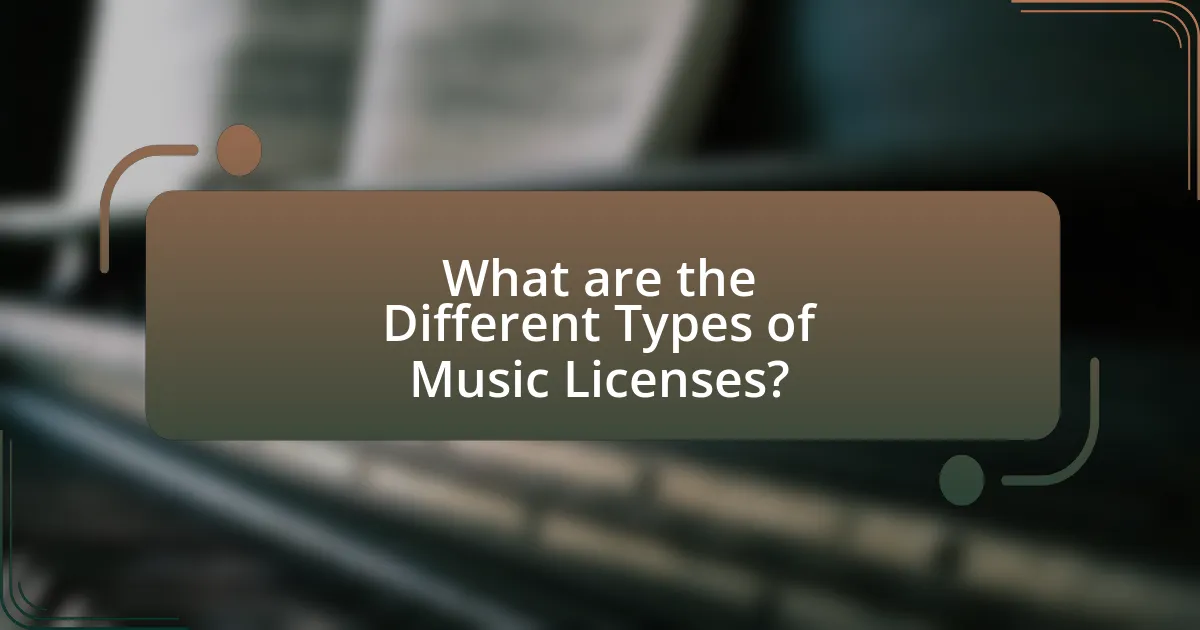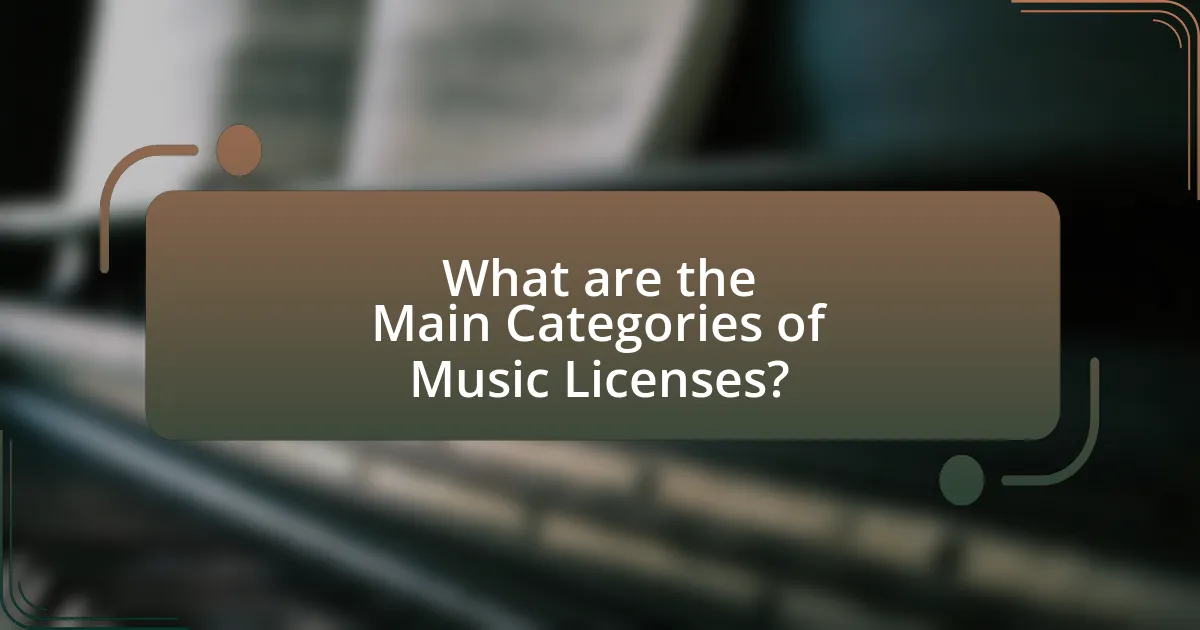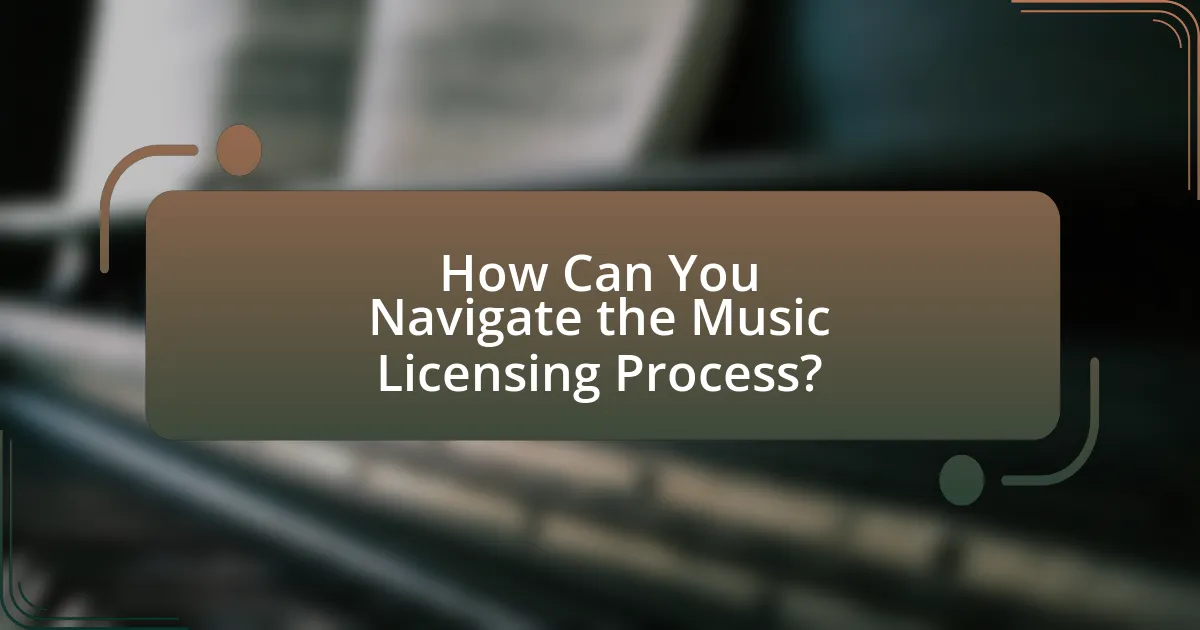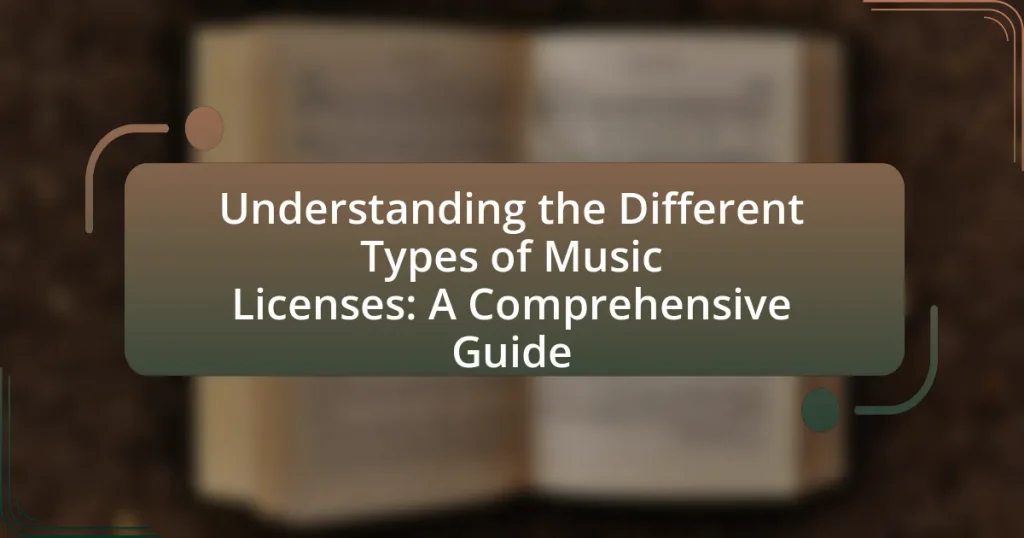The article provides a comprehensive guide to understanding the various types of music licenses, including synchronization, mechanical, performance, and master use licenses. It explains how these licenses function within the music industry, detailing their distinct purposes and the legal protections they offer to artists and creators. Key components of music licenses, the risks of operating without proper licenses, and the impact of licensing on revenue for artists are also discussed. Additionally, the article outlines best practices for navigating the music licensing process, securing the necessary licenses, and ensuring compliance with licensing agreements.

What are the Different Types of Music Licenses?
The different types of music licenses include synchronization licenses, mechanical licenses, performance licenses, and master use licenses. Synchronization licenses allow the use of music in audiovisual works, such as films and commercials. Mechanical licenses grant permission to reproduce and distribute music recordings, typically for physical formats like CDs or digital downloads. Performance licenses are required for public performances of music, covering venues like bars and concert halls. Master use licenses permit the use of a specific recording of a song in various media. Each type of license serves a distinct purpose in the music industry, ensuring that creators are compensated for their work.
How do Music Licenses Function in the Industry?
Music licenses function in the industry by granting permission to use copyrighted music under specific conditions. These licenses are essential for artists, producers, and businesses to legally incorporate music into their projects, ensuring that copyright holders receive compensation for their work. For example, synchronization licenses allow music to be paired with visual media, while mechanical licenses cover the reproduction of music on physical formats. The licensing process typically involves negotiation between the rights holder and the user, often facilitated by music licensing organizations that manage rights and royalties. This structured approach helps maintain the integrity of intellectual property while enabling creative collaboration across various media platforms.
What are the key components of a music license?
The key components of a music license include the type of rights granted, the duration of the license, the territory in which the license is valid, and the payment terms. The type of rights specifies whether the license covers reproduction, distribution, public performance, or synchronization. The duration defines how long the license is effective, which can range from a specific period to perpetual rights. The territory outlines the geographical area where the license applies, such as local, national, or international. Lastly, the payment terms detail the financial arrangements, including upfront fees, royalties, or a combination of both. These components are essential for ensuring that all parties understand their rights and obligations under the license agreement.
How do music licenses protect artists and creators?
Music licenses protect artists and creators by granting them exclusive rights to their work, ensuring they receive compensation for its use. These licenses legally define how music can be used, preventing unauthorized reproduction, distribution, or performance. For instance, a synchronization license allows a creator to control how their music is used in visual media, while a mechanical license governs the reproduction of music in physical formats. By establishing these rights, music licenses help artists maintain ownership of their intellectual property and secure revenue streams, which is crucial in an industry where unauthorized use can lead to significant financial losses.
Why is Understanding Music Licenses Important?
Understanding music licenses is important because they dictate how music can be legally used, ensuring that creators are compensated for their work. Music licenses protect the rights of artists and songwriters, allowing them to control how their music is distributed, performed, and reproduced. For instance, the U.S. Copyright Office states that unauthorized use of copyrighted music can lead to legal consequences, including fines and lawsuits. Therefore, understanding these licenses helps individuals and businesses avoid infringement and fosters respect for intellectual property rights.
What risks are associated with not having the proper licenses?
Not having the proper licenses exposes individuals and organizations to legal risks, including potential lawsuits and financial penalties. Without the necessary licenses, creators may face copyright infringement claims, which can result in costly legal battles and damages. For instance, the U.S. Copyright Office reports that unauthorized use of copyrighted music can lead to statutory damages ranging from $750 to $30,000 per work infringed, and up to $150,000 for willful infringement. Additionally, businesses may suffer reputational damage and loss of revenue due to the inability to legally distribute or perform music, further compounding the financial risks associated with operating without proper licenses.
How can music licenses impact revenue for artists?
Music licenses significantly impact revenue for artists by providing legal avenues for monetizing their work through various channels. When artists secure licenses, they can earn income from streaming services, radio play, public performances, and synchronization in films or commercials. For instance, a study by the Music Industry Research Association found that artists who actively manage their licensing agreements can increase their revenue by up to 30%. This demonstrates that effective licensing not only protects artists’ rights but also enhances their financial opportunities in the music industry.

What are the Main Categories of Music Licenses?
The main categories of music licenses are synchronization licenses, mechanical licenses, performance licenses, and master licenses. Synchronization licenses allow the use of music in audiovisual works, such as films and commercials. Mechanical licenses grant permission to reproduce and distribute music recordings, typically for physical formats like CDs or digital downloads. Performance licenses are required for public performances of music, whether live or through broadcasting. Master licenses provide rights to use a specific recording of a song, often in conjunction with other licenses. These categories are essential for ensuring that creators are compensated for their work and that users comply with copyright laws.
What is a Synchronization License?
A synchronization license is a legal agreement that allows the use of a piece of music in conjunction with visual media, such as films, television shows, commercials, or video games. This type of license is necessary because it grants permission from the copyright holder of the music to synchronize their work with the visual content. The requirement for a synchronization license is rooted in copyright law, which protects the rights of creators and ensures they receive compensation for the use of their intellectual property.
How is a synchronization license obtained?
A synchronization license is obtained by negotiating with the copyright owner of the musical work, typically the songwriter or publisher. The process involves contacting the rights holder to request permission to use the music in a specific audiovisual project, such as a film, television show, or advertisement. Once the rights holder agrees, the parties will negotiate terms, including fees and usage rights, which are then formalized in a written agreement. This process is essential as it ensures legal use of the music and protects both the creator’s rights and the user’s interests.
What are the common uses for synchronization licenses?
Synchronization licenses are commonly used to permit the use of music in audiovisual works, such as films, television shows, commercials, and video games. These licenses allow creators to synchronize music with visual media, ensuring that the rights holders are compensated for the use of their compositions. For example, a film director may obtain a synchronization license to include a popular song in a movie scene, which enhances the emotional impact and audience engagement. This practice is supported by industry standards, as synchronization licenses are essential for legal compliance and protecting intellectual property rights in the entertainment sector.
What is a Mechanical License?
A mechanical license is a legal authorization that allows a party to reproduce and distribute a copyrighted musical composition in a physical format, such as CDs or vinyl, or in a digital format, like downloads and streaming. This type of license is typically obtained by record labels or music distributors from the copyright owner, usually the songwriter or publisher, and it ensures that the copyright holder receives royalties for each copy sold or distributed. The requirement for a mechanical license is established under U.S. copyright law, specifically the Copyright Act of 1976, which mandates that anyone wishing to reproduce a song must secure permission from the copyright owner, thereby protecting the rights of creators.
How does a mechanical license differ from other licenses?
A mechanical license specifically allows the reproduction and distribution of a musical composition in a physical or digital format, such as CDs or downloads. This type of license is distinct from other licenses, such as performance licenses, which permit public performances of a song, or synchronization licenses, which allow the use of music in audiovisual works. The mechanical license is governed by statutory rates set by law, ensuring that songwriters and publishers receive compensation for the reproduction of their work, while other licenses may involve negotiations for fees based on usage and context.
What are the legal requirements for obtaining a mechanical license?
To obtain a mechanical license, one must submit a license request to the copyright owner or their representative, typically through a licensing agency. This request should include details such as the song title, the songwriter, the intended use, and the number of copies to be made. Additionally, the requester must agree to pay the statutory royalty rate set by the U.S. Copyright Office, which is currently 9.1 cents per copy for physical formats and digital downloads. Compliance with these requirements ensures that the rights of the original creators are respected and compensated.
What is a Performance License?
A Performance License is a legal authorization that allows individuals or organizations to publicly perform copyrighted music. This license is essential for venues, such as bars, restaurants, and concert halls, that host live music or play recorded music, ensuring that the rights of songwriters and music publishers are respected. Performance Licenses are typically obtained through performance rights organizations, which collect royalties on behalf of the copyright holders, thereby facilitating the legal use of music in public settings.
How do performance licenses work in live settings?
Performance licenses in live settings allow artists and venues to legally perform copyrighted music. These licenses are typically obtained from performance rights organizations (PROs) such as ASCAP, BMI, or SESAC, which represent songwriters and publishers. When a venue hosts a live performance, it must secure a performance license to ensure that the rights of the music creators are respected and that they receive royalties for the use of their work. This licensing process involves the venue paying a fee based on factors like the size of the audience and the type of music performed, which in turn compensates the songwriters and publishers for their intellectual property.
What organizations are involved in issuing performance licenses?
Organizations involved in issuing performance licenses include Performing Rights Organizations (PROs) such as ASCAP, BMI, and SESAC in the United States, as well as PRS for Music in the United Kingdom and SOCAN in Canada. These organizations are responsible for collecting royalties on behalf of songwriters and publishers when their music is performed publicly. For instance, ASCAP and BMI collectively represent millions of songwriters and composers, ensuring they receive compensation for the use of their works in various venues and media.

How Can You Navigate the Music Licensing Process?
To navigate the music licensing process, start by identifying the type of license you need, such as synchronization, mechanical, or performance licenses, depending on how you intend to use the music. Understanding the specific requirements for each license type is crucial; for instance, synchronization licenses are necessary for pairing music with visual media, while performance licenses are required for public performances.
Next, research the rights holders, which typically include songwriters, publishers, and record labels, to obtain the necessary permissions. Utilize resources like the American Society of Composers, Authors and Publishers (ASCAP) or Broadcast Music, Inc. (BMI) to facilitate the licensing process.
Finally, ensure compliance with all terms outlined in the licensing agreements to avoid legal issues. According to the U.S. Copyright Office, failure to secure proper licenses can result in significant penalties, reinforcing the importance of navigating this process correctly.
What Steps Should You Take to Secure a Music License?
To secure a music license, you should first identify the type of license you need based on your intended use of the music, such as synchronization, mechanical, or performance licenses. Next, you must locate the rights holder, which could be the songwriter, publisher, or record label, and then request permission to use the music. After obtaining the necessary permissions, you will need to negotiate the terms, including fees and duration of use, and finally, ensure that you receive a written agreement that outlines all terms of the license. This process is essential because using music without proper licensing can lead to legal consequences, as copyright law protects the rights of music creators.
How do you determine which type of license you need?
To determine which type of music license you need, first identify the specific use of the music, such as whether it will be used for public performance, synchronization with visual media, or reproduction. Each use case requires a different type of license; for example, a public performance license is necessary for playing music in venues, while a synchronization license is needed for pairing music with video content. The necessity for these licenses is supported by copyright law, which mandates that creators receive compensation for the use of their work.
What resources are available for obtaining music licenses?
Resources for obtaining music licenses include performing rights organizations (PROs) such as ASCAP, BMI, and SESAC, which facilitate licensing for public performances. Additionally, music licensing companies like Songfreedom and Audiosocket provide access to licensed music for various media uses. Online platforms such as Soundstripe and Epidemic Sound offer subscription-based models for licensing music tracks. Furthermore, direct licensing from music publishers and record labels is also a viable option for acquiring specific song rights. These resources collectively ensure that users can legally obtain the necessary licenses for music usage across different platforms and formats.
What Common Mistakes Should You Avoid in Music Licensing?
Common mistakes to avoid in music licensing include failing to obtain the correct type of license, neglecting to read the licensing agreement thoroughly, and assuming that a single license covers all uses. Obtaining the correct license is crucial because different types of licenses, such as synchronization licenses for film and mechanical licenses for physical copies, serve distinct purposes. Neglecting to read the licensing agreement can lead to misunderstandings about usage rights and restrictions, potentially resulting in legal issues. Additionally, assuming that one license suffices for various platforms or media can lead to copyright infringement, as each platform may require specific licensing terms. These mistakes can result in financial penalties and damage to professional reputation.
How can misinterpretation of license terms lead to legal issues?
Misinterpretation of license terms can lead to legal issues by causing individuals or organizations to use copyrighted material without proper authorization. When license terms are misunderstood, users may inadvertently infringe on copyright laws, resulting in potential lawsuits or financial penalties. For example, a study by the Copyright Office indicates that unauthorized use of music can lead to statutory damages ranging from $750 to $30,000 per infringement. This highlights the importance of accurately understanding license agreements to avoid legal repercussions.
What are the consequences of using music without a license?
Using music without a license can lead to legal consequences, including copyright infringement claims, financial penalties, and potential lawsuits. Copyright holders have the right to enforce their intellectual property, which can result in fines that range from hundreds to thousands of dollars per infringement. Additionally, unauthorized use may lead to the removal of content from platforms, loss of revenue, and damage to reputation. According to the U.S. Copyright Office, unauthorized use of copyrighted music can result in statutory damages of up to $150,000 per work, emphasizing the financial risks involved.
What Best Practices Should You Follow for Music Licensing?
To ensure compliance and protect your rights in music licensing, follow these best practices: always obtain the necessary licenses before using music in any project, whether for commercial or personal use. This includes securing synchronization licenses for audiovisual works and mechanical licenses for reproducing music. Additionally, maintain clear documentation of all licensing agreements to avoid disputes and ensure proper attribution. Regularly review and stay updated on copyright laws and licensing requirements, as they can change. According to the U.S. Copyright Office, failure to secure proper licenses can lead to legal repercussions, including fines and lawsuits.
How can you ensure compliance with licensing agreements?
To ensure compliance with licensing agreements, organizations must implement a systematic approach that includes thorough documentation, regular audits, and staff training. Documentation involves maintaining accurate records of all licenses, including terms and conditions, to ensure all parties understand their obligations. Regular audits help identify any discrepancies or unauthorized use, allowing for corrective actions to be taken promptly. Additionally, training staff on the specifics of licensing agreements fosters a culture of compliance and awareness, reducing the risk of violations. These practices are supported by industry standards, such as the Copyright Act, which outlines the legal framework for licensing compliance.
What tips can help streamline the licensing process?
To streamline the licensing process, individuals and organizations should prepare all necessary documentation in advance. This includes having clear records of ownership, usage rights, and any agreements related to the music. Additionally, utilizing online licensing platforms can expedite the process by providing standardized forms and reducing the need for back-and-forth communication. Research indicates that organizations that maintain organized records and use digital tools can reduce licensing time by up to 30%, as noted in a study by the Music Licensing Coalition.
